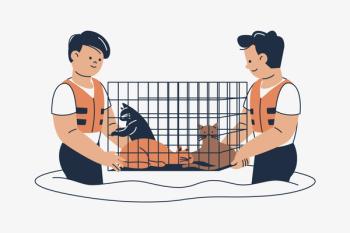
After vicious attack, a sheltie is back from the brink
A week-long succession of wound repair surgeries results in Cody's successful recovery.
The road to this involved wound closure was long for Cody, a 4-year-old sheltie. (Images courtesy of BluePearl)An attack that resulted in a deep cut on the right side of his neck and three other large wounds on his right thoracic area almost killed Cody, a 40-lb, 4-year-old sheltie in Tomball, Texas. His owners, who had run out for an errand, returned to find Cody covered in blood from these severe injuries, likely cause by a coyote or another dog.
They rushed Cody to North Houston Veterinary Specialists, a BluePearl 24-hour emergency and specialty center in Spring, Texas. In a release, Benjamin Perry, DVM, MS, DACVS-SA, says that upon examining Cody's wounds, “we realized that that was kind of the tip of the iceberg.” Cody had also suffered a crushing force from being grabbed and shaken.
The wounds were so severe that Cody's owners initially considered euthanizing him, but they opted instead for treatment, which ended up involving a week's stay and a series of surgeries at the specialty clinic.
Because the wounds were so large and extensive, they were not able to be sutured initially. Perry had to connect the two largest wounds on Cody's chest since the tissue was so thin that he needed to prevent excessive tension and a compromised blood supply.
To get the wounds in shape for eventual suturing, Perry débrided Cody's wounds daily and applied fresh wet-to-dry bandages once or twice a day until a bed of granulation tissue formed. The wounds were undermined to create flaps, and the bandages placed gradual tension on the wounds to train them to obtain their blood supply from the base of the flaps.
After five days of this preparation, the wounds had a good blood supply and were finally able to be sutured. Perry used a
Cody is recovering well from his wounds inflicted by an unknown canine attacker.Cody is back home happy and healthy, his hair now almost covering the scars from the extensive wound repair. But the mystery about Cody's attack remains.
“Our dog is lucky to be alive, and we still don't know what would have done that,” says Danitha Hess, one of Cody's owners, in the release.
Newsletter
From exam room tips to practice management insights, get trusted veterinary news delivered straight to your inbox—subscribe to dvm360.




